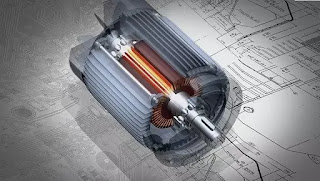Axial vs Radial Flux Motors and Why Axial flux is a better engine for EVs
In an Electric vehicle, Electric motors are the true driving force apart from Battery. It is the engine of electric vehicles and reports say around 100 million motors are required per year by 2032 to meet the EV Demands. Electric traction motors are first discovered in the 1800s but the technology is still evolving with improved technology, efficiency, and less rare earth materials.
The basic operation of the electric motor is based on the electromagnetic interaction created by the structure coil and magnet. Based on the direction of the magnetic field, these motors are divided into:-
- Radial Flux
- Axial Flux
The fundamental difference between both lies in the orientation of the magnetic field w.r.t the electric coils.
 |
| Credits:- Linquip.com |
Radial flux motors are classic cylindrical shaped which produce flux perpendicular to the axis of rotation. Features of radial flux motors are designed on the sides and copper windings are wrapped around the slots. In traditional radial flux BLDC motors, the rotor of permanent magnets is stacked inside the stator.
In this case, Stator is supported by Yoke, which is outfitted in teeth containing electromagnetic coils, and the teeth function as alternating magnetic poles. And at the same time, the rotor’s magnetic poles interact with the alternating magnetic flux of the wound stator teeth, resulting in the motor’s torque.
Though radial flux motors are commercially successful for decades, it is considered less efficient compared to modern Axial flux technology. An axial flux motor will have 30-40% more torque than a similar-sized radial motor.
Axial Flux
Axial flux motors have a different geometry compared to radial flux. The flux generated is parallel to the axis of rotation due to the way the coil is wounded and the distance between the stator and rotor. This will also make the fabrication more simple. Interestingly, axial flux technology is also not new, but in recent times, tremendous research on this technology and the availability of strong electromagnets opens the possibility to explore the axial flux geometry advantage.
The future of Axial motor technology is driven by the Soft magnetic composite (SMC) material exclusive to powder metal. Advantages of Axial flux motor are;-
- Higher power density and Torque
- Simplified winding design and compact
- Shorter magnetic path
Why Axial Flux motor is the future for EVs?
In a radial flux motor, magnetic flux moves from one tooth to the stator, back to the next tooth, and then to the magnets. But the axial flux motor has a more efficient magnetic flux path from one magnet, through the core, to another magnet. Thus Axial flux motors have higher power density and produce 30-40% more torque than a similar-sized radial motor.
The construction of the axial motor is in a way that gives more leverage on the central axis due to the placement of magnets away from the central axis. Also, Axial flux motors provide good cooling as the windings are in close contact with the outside aluminum shell. Aluminum transmits the heat easily, and the windings of axial flux motors remain cool while the resistance of the copper remains low.
In radial flux motors, the low power/weight ratio is due to Distributed winding; this is not in the case of axial flux motors. Also axial flux motor has highly active electromagnetic materials, which reduces the percentage of winding that produces no torque and losses. This is not the case with radial flux motors which have more winding losses and longer magnetic paths. Furthermore, axial motor flux only travels in one dimension compared to two dimensions in radial flux motors to reduce iron losses and increase operating efficiency.
Axial flux motors also have the disadvantage of mechanical challenges for their construction and material availability. Thus production costs will be high. But as research on axial flux technology is in full swing, hopefully, these challenges can be overturned.
As we all know the future is all about sustainable energy and effective use of the energy sources to their maximum efficiency. This clearly indicates the importance of Axial flux motors on EVs.








Comments
Post a Comment
Please do not enter any spam link in the comment box.